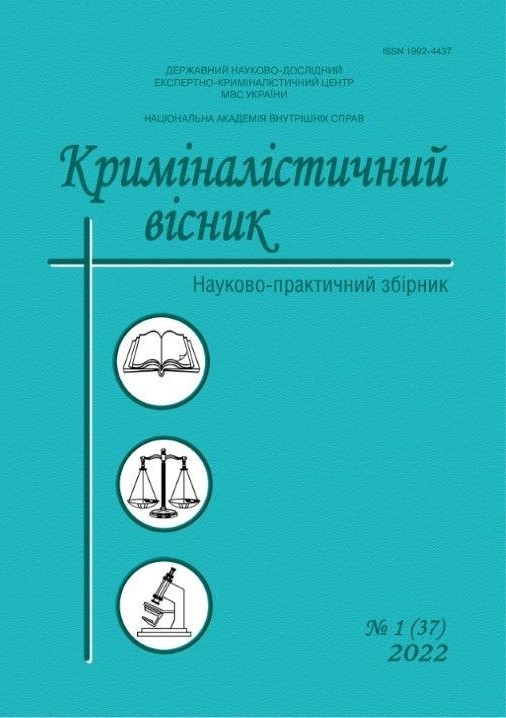ВИКОРИСТАННЯ ПОСТРІЛУ СЕРІЇ ПГ-7 ЯК СКЛАДНИКА САМОРОБНОГО ВИБУХОВОГО ПРИСТРОЮ
DOI:
https://doi.org/10.37025/1992-4437/2022-37-1-54Анотація
Мета статті – комплексне аналізування теоретичних положень і практичних проблем використання пострілу серії ПГ-7 як складника саморобного вибухового пристрою, надання відповідних рекомендацій. Методологія. Достовірність отриманих результатів і висновків забезпечено загальнонауковими (емпіричними та теоретичними) і спеціальними методами дослідження. Так, зокрема, теоретичними загальнонауковими
методами дослідження (аналіз, синтез, узагальнення) схарактеризовано наукові та інформаційні джерела за тематикою дослідження, з’ясовано рівень достатності в них профільної інформації для практичного використання. За допомогою емпіричних методів (спостереження, опис тощо) і спеціальних методів дослідження описано параметри та виокремлено особливості описаних прикладів саморобних вибухових пристроїв, а також їх залишків на місці вибуху. Системний підхід до проведення дослідження забезпечив його комплексний характер і дозволив об’єднати окремі результати дослідження (за різними конструктивними варіантами саморобних вибухових пристроїв) в єдине ціле. Наукова новизна. Окреслено конструктивні особливості окремих деталей і вузлів нетипових саморобних вибухових пристроїв, які створюються на основі маршового та стартового порохових двигунів пострілу серії ПГ-7 та 82-мм мінометної міни і протипіхотної міни ПОМ-2, а також проаналізовано та проілюстровано найбільш характерні залишки на місці вибуху описаних модифікацій саморобних вибухових пристроїв, що допоможе процесу ідентифікації та встановлення механізму вчинення вибуху. Висновки. Надано комплексну характеристику двох основних варіантів (модифікацій) саморобних вибухових пристроїв, серед складників яких конструкція маршового та стартового порохових двигунів пострілу серії ПГ-7, 82-мм мінометної міни та протипіхотної міни ПОМ-2. Окреслено конструктивні особливості окремих деталей і вузлів зазначених саморобних вибухових пристроїв. Наголошено, що конструкція проілюстрованих нами прикладів вибухових пристроїв є нетиповою і потребує відповідних знань судового експерта, аби уникнути надання помилкових (неповноцінних) висновків, що позначатимуться на процесі досудового розслідування. Розглянуто типові залишки на місці вибуху зазначених модифікацій саморобних вибухових пристроїв, за якими їх можна обґрунтовано ідентифікувати. Здійснено порівняння залишків двох основних видів (модифікацій) предмета дослідження, результати унаочнено. При цьому наголошено, що залишки спрацьованих маршового та стартового порохових двигунів пострілу серії ПГ-7 найближчі до місця вибуху, ніж протипіхотної міни, які розлітаються на значно більшу відстань. Сформульовано рекомендації практико-прикладного характеру, що допоможуть уникнути помилок, розв’язуючи питання віднесення досліджуваних вибухових пристроїв як цілісної конструкції, а не окремих пристроїв (боєприпасів) у межах судової вибухотехнічної експертизи, а також стануть у пригоді не тільки судовим експертам науково-дослідних установ, які працюють за таким напрямом, як дослідження вибухових пристроїв, слідів та обставин вибуху, а й іншим працівникам правоохоронних органів під час огляду місця події за фактом вибуху, спричиненого зазначеними саморобними вибуховими пристроями, і подальшого досудового розслідування



